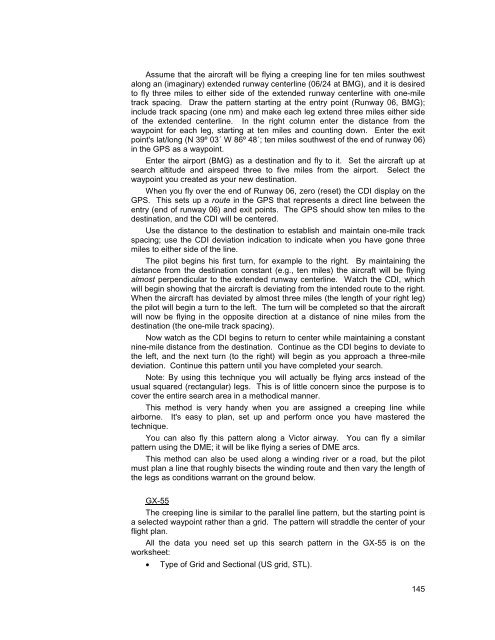MART Vol. II MO/MP - NESA - Civil Air Patrol
MART Vol. II MO/MP - NESA - Civil Air Patrol
MART Vol. II MO/MP - NESA - Civil Air Patrol
You also want an ePaper? Increase the reach of your titles
YUMPU automatically turns print PDFs into web optimized ePapers that Google loves.
Assume that the aircraft will be flying a creeping line for ten miles southwestalong an (imaginary) extended runway centerline (06/24 at BMG), and it is desiredto fly three miles to either side of the extended runway centerline with one-miletrack spacing. Draw the pattern starting at the entry point (Runway 06, BMG);include track spacing (one nm) and make each leg extend three miles either sideof the extended centerline. In the right column enter the distance from thewaypoint for each leg, starting at ten miles and counting down. Enter the exitpoint's lat/long (N 39º 03´ W 86º 48´; ten miles southwest of the end of runway 06)in the GPS as a waypoint.Enter the airport (BMG) as a destination and fly to it. Set the aircraft up atsearch altitude and airspeed three to five miles from the airport. Select thewaypoint you created as your new destination.When you fly over the end of Runway 06, zero (reset) the CDI display on theGPS. This sets up a route in the GPS that represents a direct line between theentry (end of runway 06) and exit points. The GPS should show ten miles to thedestination, and the CDI will be centered.Use the distance to the destination to establish and maintain one-mile trackspacing; use the CDI deviation indication to indicate when you have gone threemiles to either side of the line.The pilot begins his first turn, for example to the right. By maintaining thedistance from the destination constant (e.g., ten miles) the aircraft will be flyingalmost perpendicular to the extended runway centerline. Watch the CDI, whichwill begin showing that the aircraft is deviating from the intended route to the right.When the aircraft has deviated by almost three miles (the length of your right leg)the pilot will begin a turn to the left. The turn will be completed so that the aircraftwill now be flying in the opposite direction at a distance of nine miles from thedestination (the one-mile track spacing).Now watch as the CDI begins to return to center while maintaining a constantnine-mile distance from the destination. Continue as the CDI begins to deviate tothe left, and the next turn (to the right) will begin as you approach a three-miledeviation. Continue this pattern until you have completed your search.Note: By using this technique you will actually be flying arcs instead of theusual squared (rectangular) legs. This is of little concern since the purpose is tocover the entire search area in a methodical manner.This method is very handy when you are assigned a creeping line whileairborne. It's easy to plan, set up and perform once you have mastered thetechnique.You can also fly this pattern along a Victor airway. You can fly a similarpattern using the DME; it will be like flying a series of DME arcs.This method can also be used along a winding river or a road, but the pilotmust plan a line that roughly bisects the winding route and then vary the length ofthe legs as conditions warrant on the ground below.GX-55The creeping line is similar to the parallel line pattern, but the starting point isa selected waypoint rather than a grid. The pattern will straddle the center of yourflight plan.All the data you need set up this search pattern in the GX-55 is on theworksheet:• Type of Grid and Sectional (US grid, STL).145














